The Navy’s sprawling Naval Air Weapons Station China Lake has over 1.1 million acres of land and 20,000 square miles of controlled airspace at its disposal as it sits at the heart of the huge R-2508 range complex in central California. There the Navy and an army of contractors pave the way for the future of warfare, testing the newest evolutions in bombs, missiles, cannon shells, electronic warfare and communications systems, and the aircraft that will put much of them to use. These development processes often involve blowing things up in spectacular fashion.
The facility is an integral part of the gigantic, but shy weapons test, development, and evaluation ecosystem that spans all 50 states and is essential to maintaining America’s combat edge over its adversaries. Yet knowing about a place like NAWS China Lake is a lot different than having a first-hand account of what it is like to live and work there. Thankfully, Randy Smith, a civilian employee that worked at China Lake in a unique capacity for years, has offered to share his recollections about a place that he learned to love not just for its remote beauty and ‘unique’ technological sights and sounds, but also for the esprit de corps among those who work there, often under tight security restrictions. This is commonly referred to as “the China Lake way” by insiders and Randy gives us a clearer view of what the place and its motto are really all about.
How I fell into China Lake
Growing up in the Indian Wells Valley is very challenging. The area is desolate and the nearest populated area is an hour and a half drive to Lancaster for shopping, dining, or anything else for that matter. In the times of no internet and nothing else to do there were very limited entertainment opportunities other than partying or riding dirt bikes.
For the most part, unless you worked on the base or in the nearby town of Trona at the soda ash processing plants, there weren’t many career opportunities. Being a gearhead growing up I was working at an auto parts store when my fiancé saw a job in the paper for a position on base. I never thought I’d land a job like that, but I interviewed for it and low and behold got hired.

I started my working career on the base in Oct of 1989. I was hired on as a courier transporting 14-inch analog tapes that recorded data on various aircraft when they were flight testing missiles, bombs, and certain data pods of the era. I was to be located at a building next to the airfield on the base where you had to have special clearance to even get through the gate.
The airfield is north of town as are the many ranges. All these places are located in very remote areas in the desert. You may think there isn’t much out there while traveling north on Highway 395, but the range facilities are filled with radar sites, target areas, and an occasional lone laboratory with some strange engineer who hasn’t seen daylight in four days hanging out most the week by himself.
The aircraft that were being tested were A-6Es, AV-8Bs, A-7s, AH-1 Cobras, and many others. I worked for the contractor that oversaw processing the data on those tapes using Honeywell tape machines and converting them to digital tapes for processing on the VAX mainframes by data technicians or for the flight test engineers in charge of the test projects.

I also traveled to the outer ranges to collect range data tapes that got processed in the same manner. With this job function, I had to get a clearance to just be in sensitive areas which took very little time. I believe the process went so fast because I pretty much grew up in the area so they didn’t have to go far for a background check.
I immediately took to fiddling around on the VAX mainframe in my spare time, learning the system and programming various little batch commands to run minor things. In true fashion of what is termed “the China Lake way” where every one civilian and military alike worked together for one common goal. I was able to transition into a data reduction job working on the A-6E Intruder System Weapon Improvement Program (SWIP) within six months because I was learning things so fast and demonstrating my potential. This upward movement was unheard of at the time. Perhaps my boss sensed that I had more to offer than what met the eye and that’s why he hired me, or I just got lucky.
It’s all about the data
As mentioned earlier, when an aircraft was doing flight test evaluation in the ‘80s and ’90s there were a lot of parts to put together to analyze the data. The data reduction group was where that began. There were not only aircraft tapes to analyze, but also range data tapes that were recorded from the ground stations tracking the aircraft and the test articles.
The aircraft tracked time, speed, INS (Inertial Navigation System), weapon release data, and TPSI (Time and Space Position Information), amongst other things. The implementation of GPS and coupling it with aircraft INS data was in its infancy at that time and was not considered reliable for precise data recording purposes at the time.
The range tapes were often generated by mobile laser tracking stations that had to be calibrated against objects of known distance prior to the tests. The first part of breaking down the recorded data was to ensure the laser was calibrated correctly. The data from the aircraft was then merged with the range data to determine if the test results were desirable.
The aircraft, as well as the weapons they were testing, were equipped with little prism mirrors on various points so that the lasers could see them and record their telemetry at any given moment. I became involved in testing on HARM, Harpoon, cluster munitions, SLAM, and even a little-known project called Tacit Rainbow. At one point I had discovered collisions with the 1553 bus data that was being recorded on an aircraft. I went over to the hanger and had some discussions with the maintenance crew and they had found some loose connections in the bus connectors. They allowed me to sit on the cockpit which is every young man’s dream at one point or another.
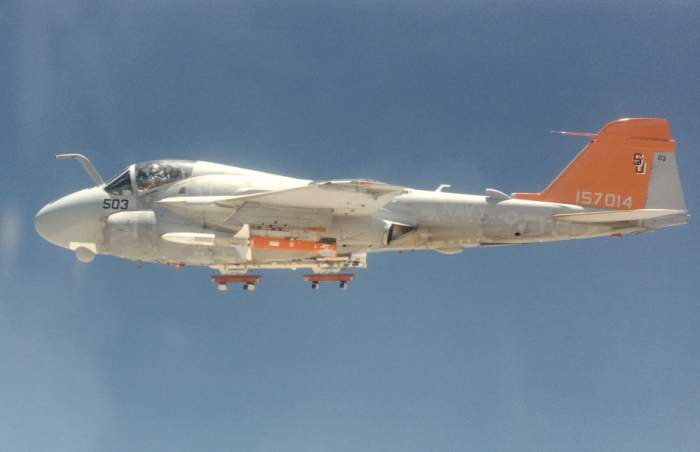
It was very interesting to see the typewriter style buttons and ancient controls in the A-6. I was also shown the bottom of this aircraft where patches were made to holes caused by ground fire from guys hiding in the rice patties when the plane was flying low over Vietnam. That aircraft was indeed old.
Not too long after I started this position the Gulf War began. The flight weapons testing got hot and heavy, but the best part was here I am just some 22-year-old hack local off the street and was put into a position to evaluate testing data in support of the A-6 missions taking place in the Middle East.
A year and a half earlier I had never touched a mainframe computer and only watched the aircraft fly in and out of the airfield. This was all new to me and very exciting. Our main focus at the time was the assessment of data generated from MK-20 Rockeye cluster munitions testing on the A-6. As Operation Desert Storm continued into the late stages of the air campaign we got the unique opportunity to perform data reduction in direct support of the bombing operations on the “highway of death” between Kuwait and Iraq. There were a couple of weeks worth of late night data processing for tests related to this event and our results of these tests went directly to the Navy in support of wartime operations.

This was a very proud moment for me to be able to participate in helping with the Gulf War effort and we as a group were recognized for our participation by the Navy Department Heads.
We each received a plaque with a personal thank you for our efforts for supporting the missions that took place. I display the plaque in my current office to this very day.
Stealth encounters
In 1992, stealth aircraft were still mysterious to mere mortals of the population at China Lake. Though there was low observable weapon testing at the time, the Navy didn’t have any stealth aircraft in testing. One of the really cool things about China Lake is the Electronic Combat Range that is located east of the main base some 30 miles called Echo Range. It’s remote and mostly hidden in the next valley not too far from the famous Pinnacles that have been stars of movies such as Star Trek and Planet of the Apes. There are many things in that area that are classified to this day, but there are a few things I can talk about what without landing in prison.
There are several interesting buildings including one that the Navy made up like a Russian ship with Russian radars for testing of various aircraft attack angles and radar avoidance. There are the various test and data collection facilities along with every type of radar you could imagine or didn’t even know existed. There are what almost looks like UHF antennas that spin and do all kinds of crazy movements and other things that make you feel that you could be fried any moment if they were pointed at you. This range is very unique and from time to time the Air Force buys some range time and flies tests of their aircraft there. The main site for aircraft testing and evaluation for the Air Force on the west coast is located at Edwards Air Force base about an hour and a half away from China Lake.
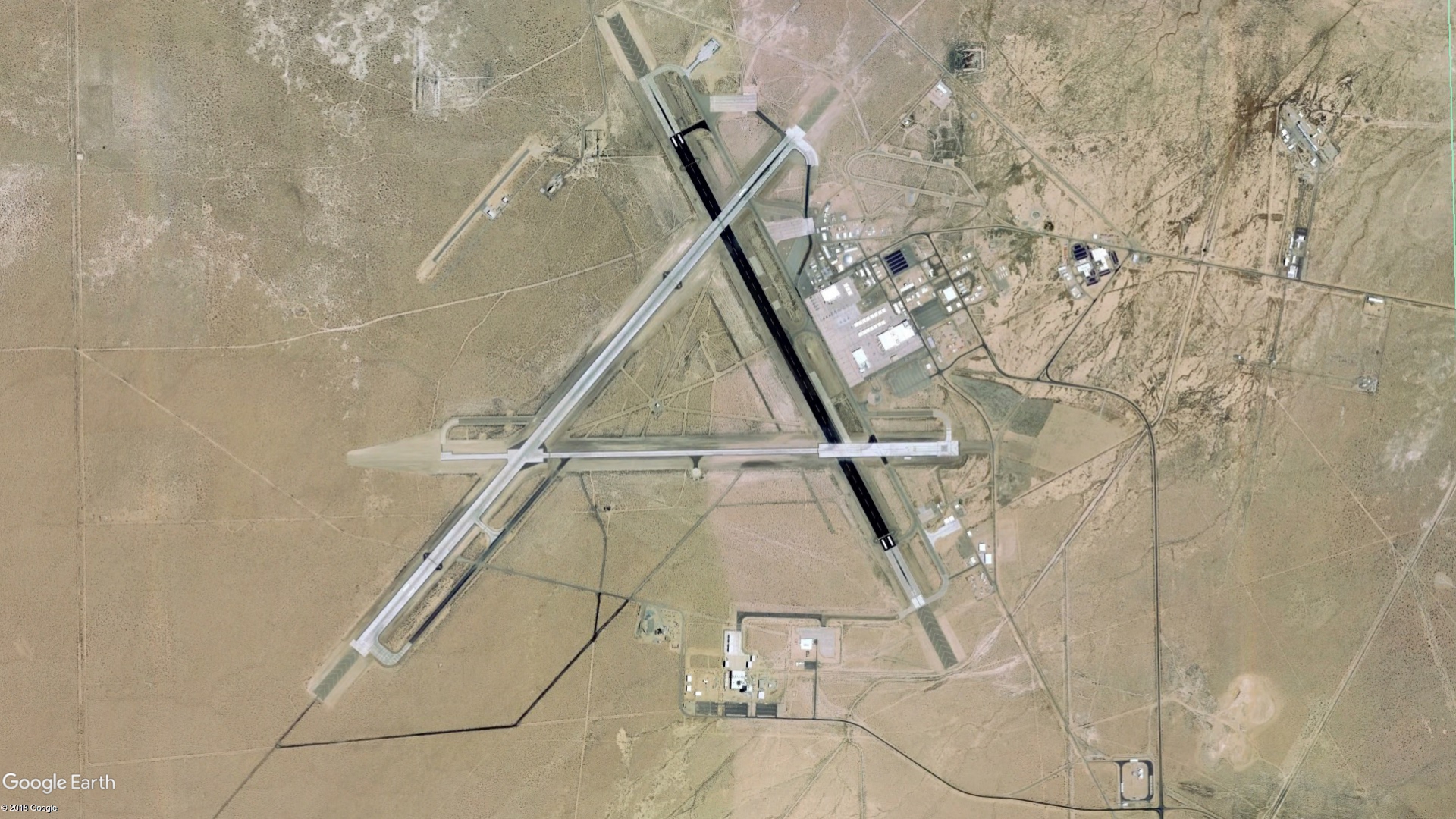
The unique thing about working at the airfield in China Lake was when something cool was flying our direction from Edwards or elsewhere, the word of its presence would spread quickly. At the time, the closest most anyone would get to a B-2 without clearance was a flyover at an air show. This aircraft is one of the most awe-inspiring flying technologies ever to be seen then and now in my opinion. It’s just a beautiful machine to watch fly and makes you feel as if you were watching some alien technology that just entered our atmosphere and was about to start raining destruction.
One day we got word that one was heading our direction after a test out on Echo Range and was going to perform a flyby. What we got was far better. We watched as it came over the horizon with two F-16 chase planes in tow. The formation banked to the north and turned back around south and then did a touch and go on the runway while the F-16’s stayed airborne a few feet above it.
A group of us were standing on the flight line and had a front row seat to this event as it came whizzing by. The most amazing thing I remember about the experience is we could not hear the B-2 over the F-16’s. It was that quiet and they were that loud. After its awesome touch and go, the aircraft ascended and headed back to Edwards. This event may not seem much, but it was very impressive to see at the time.
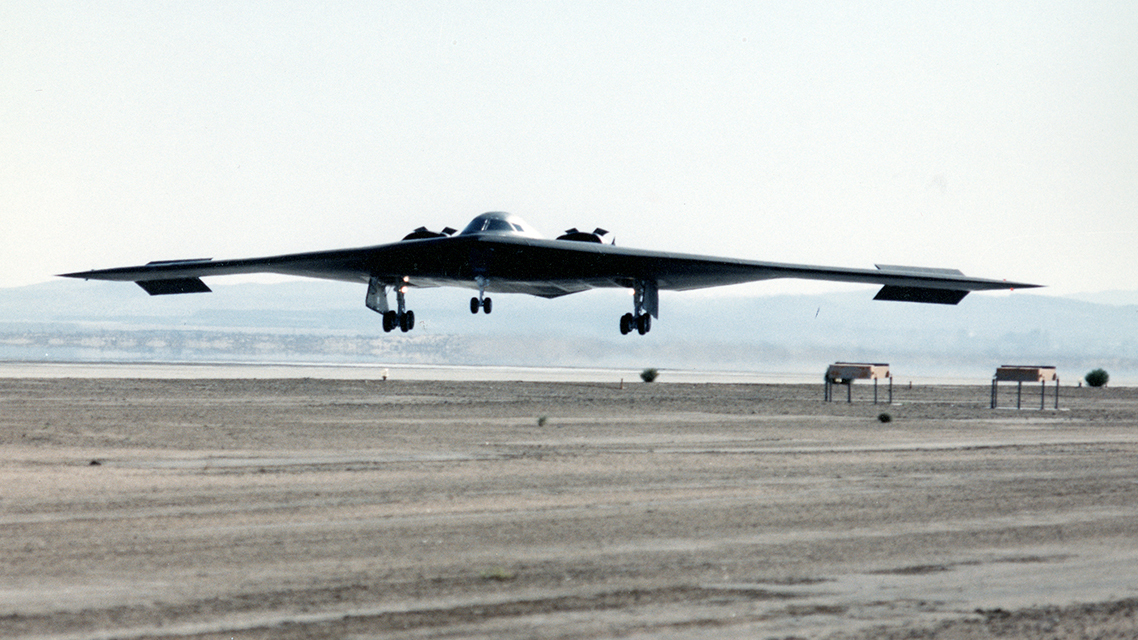
One of my fonder memories was when a group of F-117s came to the base from Edwards. They were there on an extended trip of several days to do some testing at Echo Range and were temporarily housed in Hanger 3 for maintenance. Of course, the base was buzzing about the presence of them being there. And those of us who were cleared to be out at the airfield got a special treat.
We got to go over to the hanger and check them out. When we entered the hanger, we were greeted up close in person by these magnificent pieces of technology. They were cordoned off with red tape and there were air force guards on each corner with their M-16’s poised and ready if someone decided they wanted to do some sort of nefarious deed! This aircraft was still such a sensitive asset and a national treasure that it necessitated having guards even in a restricted area.
To view this aircraft two feet in front of you is befuddling at the very least. It had very sharp angles and was so futuristic looking you couldn’t imagine that it was really able to fly, which it couldn’t without flight computers of course. The canopies were closed and there were technicians in white suits and covered shoes working and walking on them in various places. They had jars of what looked like black paint and were touching up the intake and canopy areas on the aircraft to presumably ensure it stayed stealthy.
Looking at these things in awe caused me to do something very impulsive and was in hindsight a very bad idea. When the guard closest to me looked the other way, I reached up and touched one of the air sensors on the front of the aircraft real quick. I was thankful that the group of my coworkers that were there didn’t decide that I was being inappropriate and tell on me. To this day I tell the story of how I got to touch an F-117 and lived to talk about it.
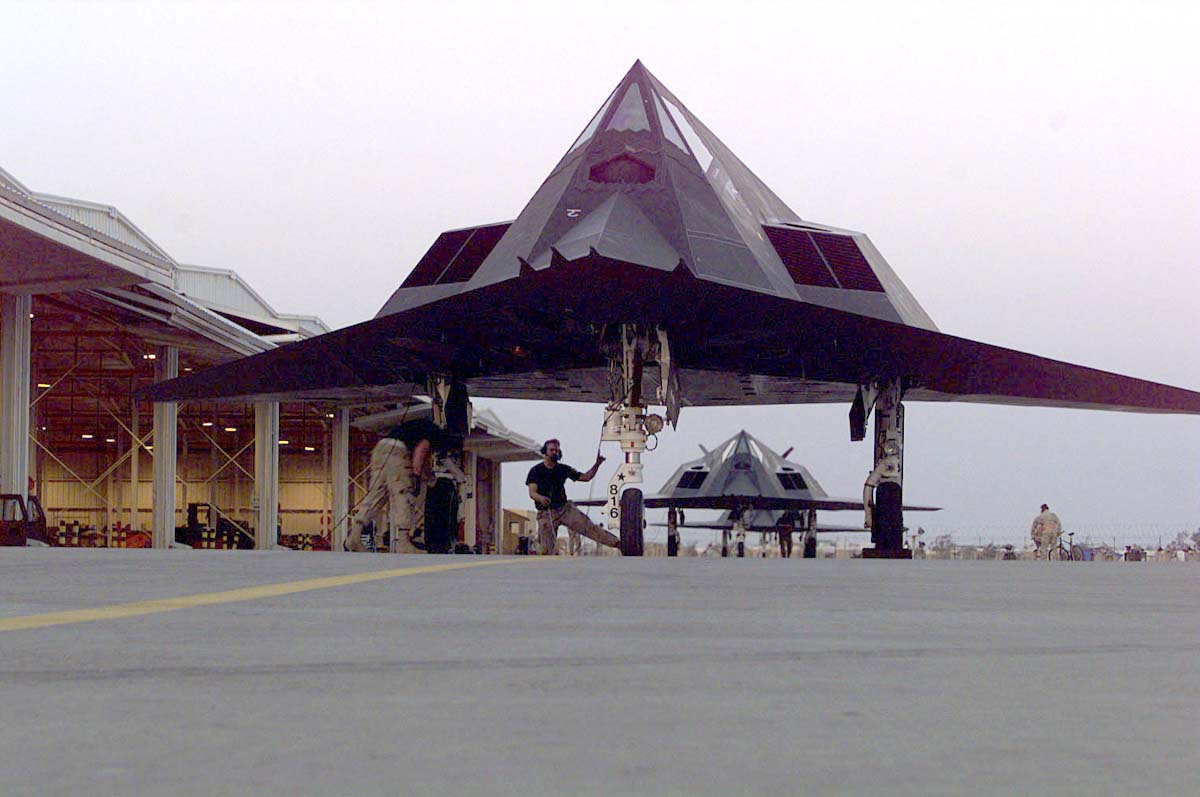
Later in the week, the F-117s could be seen flying in various places on the ranges. They were interesting to watch because they were actually quite maneuverable. They reminded me of dragonflies darting around in the sky. The sound they made from the engines enclosed inside the airframe was quite interesting as well. One day I was dropping my wife off at her workplace on the base and one was flying over very low with its gear down. It sounded like a cross between a mean weed eater from hell and the Millennium Falcon.
There were many other interesting things about working at China Lake, but those two stand out in my mind just because they were so unique at that time.
Home on the range
Working at the airfield and doing data reduction work was great, but I didn’t make a whole lot of money. Though I was considered a whiz kid for the things I had pulled off I didn’t have a formal secondary education and therefore was limited in the things I could do. I was trying to raise a young family with three kids and was struggling.
Since I wasn’t able to move into data analysis or flight test engineering I decided to take a job in the digitizing unit just for the pay increase. This was the job function of pulling the data off the analog tapes and converting it into digital. Spinning tapes was the most boring job you could get into in this arena and the workers are usually referred to as ‘tape apes.’
I then got another position working with an all-new digitizing system called the Loral 8715. This system incorporated the same Honeywell reel to reel system, but it was tied directly into a Vax 4000. This bypassed having to convert to digital format on tape and dumped the data directly into a format that the data reduction programs could work with. It was fun to be involved in as it was new but soon that became routine as well.
One day something happened that would alter the course of the career path I was currently on into another deal altogether. The evolution of the PC was starting to kick in. PCs were getting faster with larger internal hard drives, more memory, writable CD ROMs, and of course faster CPUs. One day we received a 486 DX100 in the data reduction area. It had an 8mm tape drive in it. Shortly after we started receiving 8mm tapes that were recorded on a Radar Upgrade AV-8B+ aircraft. The machine’s software broke the data down from that tape much like the 8715s had done, except it was capable of handling more data and the overall system was way less expensive and cumbersome than the 8715 system.
I was instantly drawn to the PC because it wasn’t something I had a whole lot of experience with but was highly interested in. Before long I had purchased one for home and spent every night banging away at it learning everything I could. Within a few months, I had learned much about PCs, DOS, and of course Windows software. Another job came up that was a promotion and it was with a group of folks based out of a trailer in the Michelson Lab complex. They were under contract to be essentially on call PC repairmen all over the base.
Because this contract was for the entire installation I gained access to just about every area when I got hired. As such, I got to see many cool things that were being worked on around the base and its many ranges.

Some of these facilities included the following:
The gun range
I spent a couple days working on a badly built PC at the gun range. This is where they tested guns like the 16-inch Mark 7 and Mark 8 that were taken directly off battleships and shipped to China Lake for various testing. One of the technicians out there who happened to be a good friend of my father in law (He worked on the base for 30 years) took me out to see a live fire for a reward after I finished working on their PC. Of course, we had to be back about a quarter mile in a firing bunker to keep us safe.
When that thing shot it was amazingly loud and concussive even while cocooned in the bunker. You could actually see the round come out and go down range. It was pretty impressive. I also got to see some of the targets and proximity shells they tested with. The targets resembled the 76 ball you see at gas stations except they were unpainted aluminum. What these proximity shells did was pretty wild. When they sensed they were close enough to these ball targets sitting on telephone poles they would explode shrapnel so violently that the balls ended up being literally shredded to bits.
Weapons Survivability Lab
The Weapons Survivability Lab is located way far north in a desolate area of China Lake. This place is an office building and a concrete shielded area with a huge static stand for mounting aircraft to. They gather up some old F-4s or something like that and strap it to the stand and then they shoot a missile or other implement of destruction at it, recording all the results on high-speed cameras and sensors.
I didn’t get to see a test take place but from what I’ve read, considerable amounts of destruction could take place.
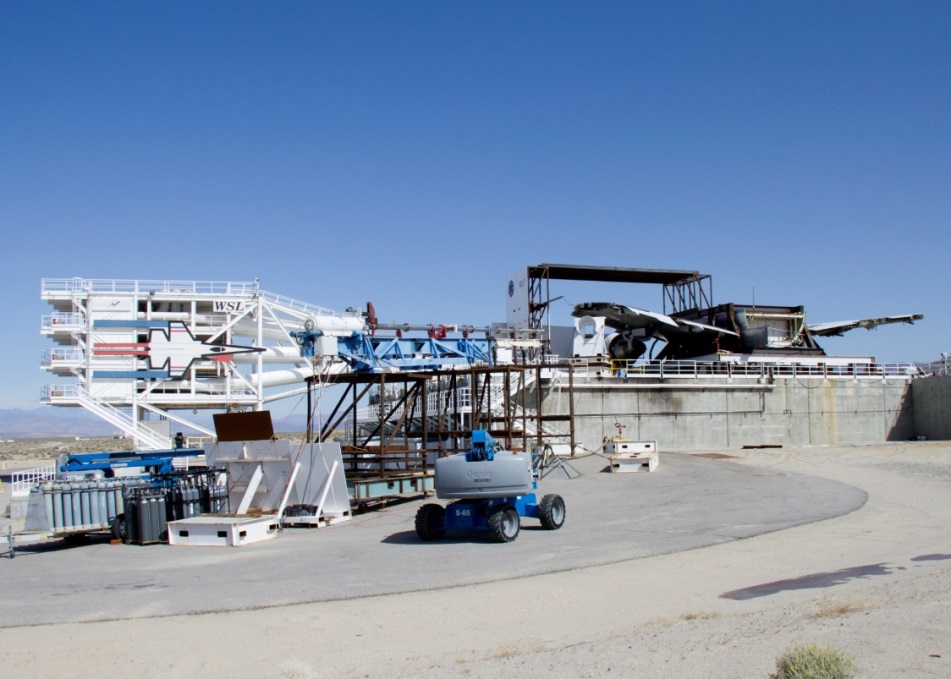
CIWS installation
This area was relatively new when I was at China Lake. It is also located far north of the other facilities because of the live fire testing. At the time, there were two Phalanx CIWS guns taken from an actual ship that was dry docked for upgrades. They were brought there to test new technologies and were to be returned to that ship after its maintenance was complete.
The guns were mounted on each side of a bunker with the controllers being inside the bunker. This bunker had various bits and pieces of shrapnel and aluminum panels lying around in front of which I thought at the time was rather odd.
They had a malfunction on one of their PCs and called us to help because there was a test scheduled later in the morning. I went out there and ended up spending a considerable amount of time rebuilding the machine because it was trashed. Because I was there so long I ended up having to stay for the duration of a test they were about to perform and all range access was temporarily locked down during it. For some reason, they didn’t think it was a good idea for me to be driving around on the range when there was live fire targeted on whatever they decided was going to die that day.
As I sat and waited I was informed to look out the bulletproof glass and to the south. What I was looking for was a Tomahawk cruise missile and apparently, the CIWS was supposed to shoot it out of the sky. That experience went from being really cool to terrifying within seconds when I spotted the Tomahawk. It dropped down in the valley along with a chase F/A-18 and started heading towards the bunker with us in it. It kept getting closer and closer until I was sure that there was some sort of problem because it appeared to target us in the bunker and I started kissing my ass goodbye. I would say it got within an either of a mile of us when the roar of the CIWS was heard from outside the bunker. It was just above us and to the right and sounded like the skies opened up with the most amazing Ppfffttaaaaaattt sound as it hurled lead at the Tomahawk.
The Tomahawk was instantly shredded, but its pieces kept flying along its original trajectory. Some of them landed in front of the bunker still in flames.
Then I realized where all the shredded metal came from.
SNORT Track
The SNORT Track at China Lake wasn’t used a lot in my day. When it did run, the whole valley knew because the rumble from the rocket sled was amazingly loud and echoed everywhere. I got to be there one time when they were executing a test. I don’t recall what they were testing at the time. I believe they had a combo of test rockets they attached to the sled to see how well the whole package would perform.
The guys in that facility were really cool and when the test was about to begin, they gathered everyone up and took them to the roof of the building to watch. It’s about a quarter mile away from where the track was, but when that thing lit off, you felt the wave of energy and enormous amount sound it put out. It was amazing. Your insides would literally vibrate.
The speed it obtained in such a short time was nothing short of astounding. When the sled reached the shutdown area it travels into several pools that were filled with water. The water flew 25 feet in the air on impact effectively slowing the sled.

Baker Range
Working at China Lake you meet many different types of people and it seems the further you get out into the ranges the more colorful of people you will find.
Baker Range was at the time definitely full of colorful people. It’s also located North of the lakebed way out in the desert. It’s a bombing complex with a huge radar system used to track aircraft and the weapons they drop. The drive out there takes about 45 minutes at real world driving speeds. However, the roads are often speed limited to 45 and even 25 in some areas in the strangest places where there is absolutely nothing.
Upon rolling through the gate and parking inside the complex I got chastised first thing in a humorous way that they were tracking me with the radar as I progressed on my way out and I had broken the posted speed limit several times.
This was just the beginning.
The outside of the radar control station looked more like a WWII shack on some war-torn island in the Pacific. However inside was nice and cool and organized with different viewing panels mounted on the walls. The radar system had an optical layout on it, so you could actually see what the radar was pointed at. They proudly displayed the visual and auto tracking feature on a jackrabbit about two miles down range. The radar followed it on its own as it went about its business and the image was crystal clear like you were 50 yards from it.
Pretty impressive.
This group let me hang out for a bomb test session with an F-14 out of NAS Point Mugu which was a real treat. Watching that F-14 come in low over the desert at 600 miles an hour 200 feet off the ground was exhilarating. It would get close to the bombing complex and then pull up and release the inert test bombs. They would lob into a pad of real thick sand. After four of those runs, he was out of bombs and left. The range guys asked me if I wanted to go downrange on their ATV’s with them to pick up the bombs. I had to decline, but I wish I could have.
MESA
We were called out to the new MESA (Missile Engagement Simulation Arena) complex not too long after it had opened for business. Apparently, the whole system used to reposition test items and missile seekers were controlled by a PC that died. MESA is a huge building and in the middle of it was an F-4 Phantom suspended from the ceiling that looked like a toy because the building was so big. The walls were all covered in cone-shaped foam that’s supposed to filter out any background noise that might interfere with testing.
Very interesting place.

Range Control Center
Occasionally I would have to take a trip over to the RCC. This building oversees all testing done in the main China Lake ranges. It’s almost like an airport control tower except there are big screens that showed real-time data and video of the tests being run at the time. Very cool place to spend a couple hours watching the various activities taking place on the ranges.
Telemetry Pad
“T-pad” is the area where surface information is sent for recording from the various range and radar devices located around the range complexes. I used to have to make trips out there to pick up tapes. Another remote location with some interesting characters.
Looking back
These are most of the operating areas that I can get into without getting myself in trouble. There are many more in the list I can’t really write about and I’m sure there are new ones that have cropped up since I’ve left.
I continued to do PC work at these various places until once again I ran into an under wage scenario. Along with that, I was also wanting to leave the area for my own reasons. A job position came up at White Sands New Mexico and I made probably one of the worst and best decisions in my career and applied for the transfer. My boss knows that I was batshit crazy for volunteering to uproot my family and take them to New Mexico on a drop of a hat, but I happily agreed to it.
I wanted to stay close to aircraft operations, but I wanted to make more money too and ended up chasing the dollar. I miss working at China Lake because to me it had everything I ever liked working with, as well as everyone there seemed like family. Nothing would ever compare to working at there in my mind.
The minute I left I regretted it and still do to some degree. Not only do I miss working there, but I also miss being in the area. It’s a very unique place.

Contact the editor: Tyler@thedrive.com
